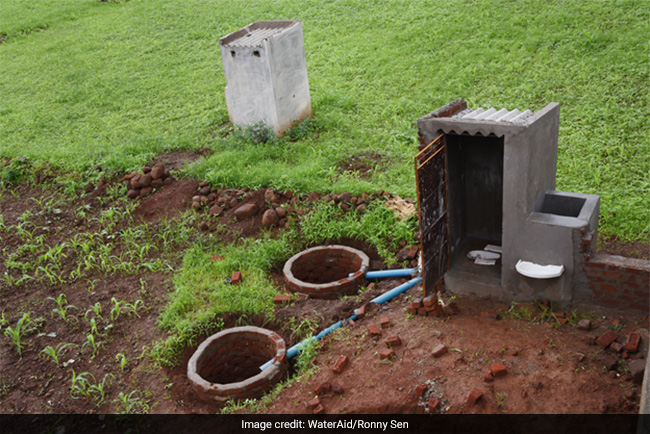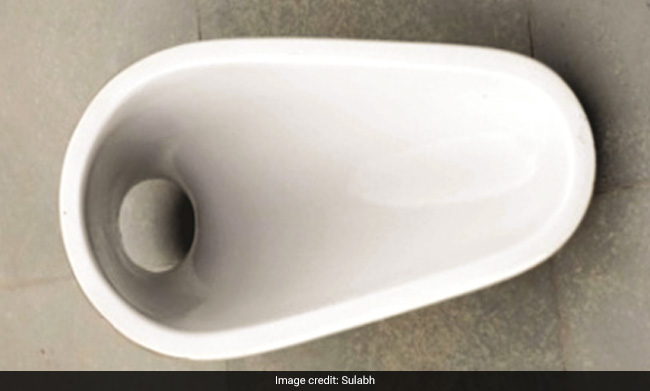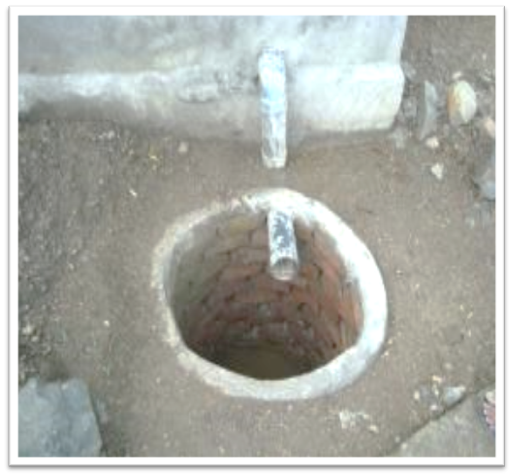Highlights
- Twin pit is a recommended toilet technology by World Health Organisation
- The government provides Rs. 12,000 for the construction of twin pit toilet
- Twin pit toilet converts human waste into manure without any treatment
New Delhi: It is 11 am and the people of Marora village in Nuh district of Haryana are caught up with their daily routine, with some busy working in their farms while others are finishing their household chores. As we walk through the narrow lanes, looking at the blue and pink coloured toilets with the name of the owners neatly written on them, villagers call us to show their “well built and maintained” toilet as if it’s some treasure. Mehboobi, a resident of the village, boasts about the shining twin pit toilet she and her husband now possess and says, “Until 2017, we had to go to a barren land or in the fields far away to relieve ourselves. At night or when it rained water would accumulate, it would become difficult for us, especially for girls to go out and defecate. Now my husband and I can use the toilet whenever we want.”
Also Read: World Toilet Day 2020: All You Need To Know About The Theme And Significance
Similar stories were narrated by other villagers as the NDTV team visits the now open defecation free (ODF) village. The villagers relive the transition from defecating in the open to now owning a toilet. In 2017-18, Sulabh International constructed 95 twin pit toilets in Marora village of Haryana.
A twin pit toilet looks and functions more or less like a regular toilet but with an added benefit of converting human waste into manure. It is a recommended toilet technology as per the World Health Organization (WHO) and was promoted under Swachh Bharat Abhiyan as well. Here is what a twin pit toilet is.
Twin Pit Toilet Technology
The twin pit pour flush toilet or twin leach pit toilet is a toilet with a provision to manage fecal waste locally unlike regular toilets that are linked to the sewer network and the fecal waste once flushed down is transported from other households through pipes and drainage system to a sewage treatment plant.
While a twin pit toilet lacks the piped network or link to the sewage treatment plant, still it ensures that the human waste is treated naturally without polluting water bodies or the soil. The main feature of this toilet technology is the two pits are used alternatively, to ensure onsite fecal sludge management making it a complete on-site sanitation solution at the household level.
Twin Leach Pit Toilet: How It Works
The two pits are connected with a junction chamber (a Y shape chamber that restricts the flow of waste to one leach pit at a time). After every use, while the liquid waste percolates into the soil through honeycomb structure of the pit, fecal waste gets collected in the pit.
In a family of five, a pit gets filled in two to three years. When the first pit gets filled, the flow of excreta has to be diverted to the second pit via the junction chamber. The content in the former pit can be left unattended for two years to degrade and turn into manure which can then be used for agriculture purposes or sold at a nominal price. Hence, waste to wealth, says Sanjeev Shekhar Jha, Project Leader, Learning and Knowledge Management, India Sanitation Coalition, FICCI.
While using a twin pit toilet, users are advised to not use heavy cleansing materials as they may hamper the quality of manure. Also, while cleaning, usage of high amount of water will result in the pit getting filled early.
Construction Of A Twin Pit Toilet
The government under the Swachh Bharat Abhiyan provides a subsidy of Rs. 12,000 to construct an individual household toilet and promotes twin pit toilet for onsite waste management.
I have worked in areas like Jharkhand, Assam and I’m a clear witness of the fact that a basic twin pit can be constructed at a cost of Rs. 12,000, says Mr Jha.
Along with offering safe sanitation, twin pit pour flush toilet is affordable as compared to traditional toilets and also don’t require regular water supply as opposed to toilets with flush which require regular piped water supply.
Here is how an ideal twin pit toilet should be constructed:
Two pits: Two three feet deep circular pits are dug one beside the other. While pit walls have a honeycomb structure, the bottom is not plastered, and is earthen. Bricks joined in a 1:6 cement mortar ratio are most commonly used for lining. Other locally available materials like stone, wooden logs, cement concrete ring, burnt clay or even discarded coal tar drum can also be used for pit lining.
Honeycombing spaces in the pit are provided for passage of gases and water, but excessive space allows fecal matter to leach as well. To avoid this, two inch wide holes should be made in every alternate layer and each layer should have six to eight holes only. When using concrete rings, they need to be perforated in the same way, says Raman VR, Head of Policy at WaterAid India.
“A distance of three feet is to be maintained between two pits to avoid inter pit contamination. If space is not adequate to maintain sufficient distance, pits can be placed in proximity to each other with a cement wall in between”, says Mr Jha.
The distance between two pits can be more than three feet, but then the pipe that connects the toilet pan with pit will need to be longer, leading to more water requirement. And more water in the pit means pit will fill up quickly.
Also Read: Journey Of Sanitation And Hygiene Practice In Rural India
Location And Shape Of Two Pits: Ideally the pits are constructed at the backside of the toilet, but depending on the availability of the space, the position of the pits can be changed.
We got the two pits constructed in front of the toilet. Since they are underground and are covered with cement and RCC (Reinforced Cement Concrete) slabs to avoid entry of water in the pits, they don’t come in the way anyway. Therefore, it is completely okay to construct the pits anywhere around the toilet, says 75-year-old Gangadas, a resident of Marora village.
A pit may be circular, square, rectangular or linear in shape depending on the availability of space.
Pan: The ceramic toilet pan used in the pit toilet has a steep slope of 20-29 degree and requires 1.5 to 2 liters of water to flush out the excreta as opposed to normal toilets with a flush which on an average require 6 litres of water.
Water Seal/Trap: Water seal or trap connects the toilet pan with the leach pit. Ideally, a water seal in pans should be of 20 mm only. Water seal more than 20 mm should be avoided as they require more water, leading to reduction in the life of a leach pit.
Pipe connecting toilet pan and pit must be straight. Use of bends make flushing harder, requires more water and leads to malfunctioning of the toilet, says Raman VR, Head of Policy at WaterAid India.
Junction Chamber: To restrict flow of excreta to one leach pit at a time, a Y shape junction chamber is connected to the two pits. The junction chamber has one inlet connected to the P-trap and two outlets connected to the leach pits. To ensure the flow of excreta in one pit at a time, one of the outlets of the Y-junction in the junction chamber is blocked while the other outlet is kept open.
Also Read: Promoted Under The Swachh Bharat Abhiyan, A User Assesses The ‘Twin Pit’ Toilet Technology
NDTV – Dettol Banega Swasth India campaign is an extension of the five-year-old Banega Swachh India initiative helmed by Campaign Ambassador Amitabh Bachchan. It aims to spread awareness about critical health issues facing the country. In wake of the current COVID-19 pandemic, the need for WASH (Water, Sanitation and Hygiene) is reaffirmed as handwashing is one of the ways to prevent Coronavirus infection and other diseases. The campaign highlights the importance of nutrition and healthcare for women and children to prevent maternal and child mortality, fight malnutrition, stunting, wasting, anaemia and disease prevention through vaccines. Importance of programmes like Public Distribution System (PDS), Mid-day Meal Scheme, POSHAN Abhiyan and the role of Aganwadis and ASHA workers are also covered. Only a Swachh or clean India where toilets are used and open defecation free (ODF) status achieved as part of the Swachh Bharat Abhiyan launched by Prime Minister Narendra Modi in 2014, can eradicate diseases like diahorrea and become a Swasth or healthy India. The campaign will continue to cover issues like air pollution, waste management, plastic ban, manual scavenging and sanitation workers and menstrual hygiene.
[corona_data_new]






































